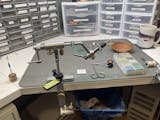Description
- Rotary vise with 8 indexing positions
- 360-degree rotation for versatile tying angles
- Adjustable friction screw for customized tension
- Available in base or c-clamp options
The Ultimate Indexer features ball bearings for smooth rotation and an indexing knob that clicks at 8 angles as you rotate the head plus added benefits like a freely rotating body, an innovative angle adjustment shaft (which allows the whole vise to angle up or down), advanced bobbin mount design (it moves up, down and around) and an additional 90 degree handle. This vise also has tool steel jaws that will accommodate hooks ranging from size 24 to 10/0, brass knobs all throughout the vise, a hardened cam lever, rotational lock and drag adjustment, and a forcing cone which adjusts the tension.
The Dyna-King Ultimate Indexer Vise is an indispensable tool for dedicated fly tyers seeking precision and versatility. With its innovative 8-position indexing feature, this vise allows for incremental rotation, ensuring your epoxy bodies cure perfectly at each stage. The seamless 360-degree rotation and adjustable tension, controlled by the indexing knob and friction screw, provide a smooth, customizable tying experience.
Crafted with quality and functionality in mind, the Ultimate Indexer Vise offers exceptional flexibility. Adjust the pitch of the head unit to suit your tying preferences, and enjoy the choice between a stable base or a versatile c-clamp to fit your workspace.
Ultimate Indexer FAQs
What makes the Ultimate Indexer Vise different from other rotary vises?
The Ultimate Indexer Vise features 8 indexing positions at 45-degree intervals, allowing for precise control over the rotation and curing process, unlike standard rotary vises.
Can the tension be adjusted while tying?
Yes, the friction screw allows for variable adjustability, enabling you to fine-tune the rotation speed and tension according to your needs.
Is the vise suitable for all fly tying techniques?
Absolutely. The Dyna-King Ultimate Indexer Vise is designed to accommodate a wide range of fly tying techniques, thanks to its adjustable head pitch and versatile indexing options.
You may also like
Recently viewed
Customer reviews
I recently pulled the trigger on the Dyna King Ultimate Indexer (C-clamp). I have been tying for many years on Regals and, in the day, a Thompson A. My last Regal, a stainless, had a very tiny micro chip in one of the jaws. No big deal, it's still functional and marginally needs repair. I could send it back to Regal but I'll just relegate it to my travel kit. Plus, this gave me a lame excuse to buy the new Dyna King! More importantly I wanted to dive into true rotary tying to improve my skills and see what all the hoopla is about. So I thought I'd try something new.
The UI meets all my expectations. Initially it took some getting used to with the switch from the Regal. Little things like where to rest my non-tying hand, which way to adjust the forcing cone, where to grab the vise to rotate it and getting hooks set in the jaws just right, among other tying details. However the more I use it and become comfortable with it, the more I like it. I have already done the true rotary thing enough to understand its advantages and will continue to utilize this technique.
Although Dyna Kings are known for their large hook capability, what I really like about the UI is its great access, visibility and holding power on tiny hooks. I routinely tie down to 26s and occasionally 28s and 30s. Although I went ahead and purchased the midge jaws from another vendor, the standard jaws, if adjusted properly, hold these hooks securely with maximum hook access. The edges of the jaws are milled very precisely at right angles and match up exactly. I don't have to worry about the jaws spitting out a tiny hook and slamming shut, potentially damaging the jaws like the Regal which are milled ever so slightly rounded, even on their stainless model. If I do damage the jaws on the DK or they become worn, I like the idea of simply replacing the jaws rather than sending the whole vise off to the factory.
The outrigger style c-clamp is a big advantage over a standard c-clamp and holds the vise rock solid, especially if your tying desk, like mine, is made out of cheasy particle board or some other thin or flexible material. The ability to make adjustments to the head angle, length, rotary tension and so on is superb. The only downside of the vise, almost so minor not to mention, is the material spring does not hold material very well and it's location on the stem is too far from the jaws without spooling out additional material to reach the spring resulting in material waste. The spring might be OK for holding trailer hooks and materials on larger flies. My workaround was to simply put a standard material spring around the head of the vise, much closer to the jaws. Otherwise great vise!
This is an excellent vice. As someone else mentioned in their review, it is a pleasure to sit down and tie with this vice.
The ultimate is a wonderful vise and you won't be disappointed with your purchase. It has definitley helped in improving my tying quite a bit. It's a pleasure to sit down and tie on this beautiful vise.












